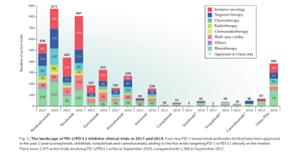PD1/PD-L1-targeted monoclonal antibodies or mAbs have emerged as the backbone of treatment for numerous types of cancer. But, over the past few years, it is obvious there are more attention on how to further maximize these inhibitors to potentially help more patients in need. Since the first PD-1 inhibitor pembrolizumab or Keytruda® by brand name was approved by the U.S. Food and Drug Administration (FDA) in 2014, PD-1/PD-L1 inhibitors have quickly become the center of immuno-oncology drug development, with a total of 9 treatments on the market globally. And, as treatments show promise and focus from researchers, sponsors, and patients grow, the industry has an opportunity to learn more and help elevate research around various disciplines in the space.
To better understand the trends and areas of focus in clinical development around this class of treatments over the last few years, IQVIA partnered with the Cancer Research Institute, a US non-profit cancer research organization, to analyze the landscape, gathering insights from investigators, key opinion leaders (KOL), and existing clinical learnings from across the US, Europe, and Asia. The findings were published in Nature Reviews Drug Discovery. To learn more, read Trends in Clinical Development for PD-1/PD-L1 Inhibitors.
An evolving landscape
Since 2006, nearly 3,000 trials have launched and are still active (as of 2019) examining PD-1/PD-L1 mAbs alone or in combination with other treatments. Of note, 76% of the active trials focus on testing combination therapies of these inhibitors with other cancer therapies, including targeted therapies, chemotherapies, radiotherapies, and more. This priority focus has resulted in:
- 14 FDA approvals of combination therapies that benefit patients living with kidney cancer, endometrial carcinoma, non-small-cell lung cancer, and more.
- 295 drug targets are currently being tested in combination with PD1/PD-L1 inhibitors.

Click image above to download the article and view graph
The industry already has a breadth of data showing how these therapies are beneficial to treat major types of cancer such as melanoma, breast cancer, and more. With the potential to expand how combination strategies can be utilized to treat rare forms of cancer or serve as tumor-agnostic therapy options regardless of cancer type, survey findings show that PD-1/PD-L1 trial sizes are getting smaller as well. These smaller targeted trials are focused on patient populations requiring biomarker enrichment, to improve patient response—adding more growth and complexity to the oncology trial landscape.
Shaping innovation for patients in need
To ensure the right patients are identified, recruited, and enrolled in the right trials, innovative solutions need to meet the demands and challenges of novel research around PD1/PD-L1 combination therapy strategies.
Virtual trial solutions
According to the analysis, China has the highest patient recruitment rate for PD-1/PD-L1 clinical trials, especially as patients with cancer there do not already receive these mAbs as a form of treatment. In markets such as the US and western Europe where recruitment is more challenging, incorporating virtual trial elements can help improve and accelerate the process and has been increasingly adopted during the COVID-19 pandemic. By working through virtual elements such as telemedicine, providing closer locations for assessment visits, direct-to-home medication delivery, and more, the burden placed on patients can be reduced, which is critical for those living with cancer and caregivers as well. And, patients can participate in trials from around the globe—helping researchers overcome challenges of recruitment and engagement.
Enhancing patient-to-trial matching
Patient identification and recruitment for smaller, targeted trials can be cost and time-intensive. In many cases, identifying and recruiting the right patients for individual trials takes several months to search and vet thousands of patient records. Given the rising trend to study PD1/PD-L1 based combination therapies in rare cancer populations, there's a need for new approaches such as leveraging real world insights to help identify these rare patients in less time.
We work closely with our molecular profiling partners to narrow down the pool and identify patients with the appropriate tumor profiles, which significantly reduces prescreening time and efforts. In some cases, we’re able to reduce prescreening processes by months. When time is of the essence, this is extremely valuable to sponsors and patients who are waiting for viable treatments.
Bringing data scientists into the site selection process helps too. We can identify the location of target patient populations and then activate sites nearby. For trials examining tumor agnostic therapies, biomarkers help us identify the right patients. Study teams can go as far as to pinpoint sites that are using next generation sequencing DNA technology as part of their standard of care, as they may be more likely to have patients who qualify for a tumor agnostic trial.
Shifting the paradigm: early engagement
As trends continue to evolve around PD-1/PD-L1 inhibitor use in combination with targeted therapies, one thing remains certain: patients with cancer cannot afford to wait for new treatments. As the industry shifts focus from major types of cancer to niche indications, smaller trials targeting rare mutations face more competition for patients. Payer reimbursement programs may need to adapt as well. It is important that sponsors engage all critical stakeholders early in the oncology clinical development process so innovative approaches can evolve with the trends and life changing therapies reach patients who need them quicker.
To learn more, read Trends in Clinical Development for PD-1/PD-L1 Inhibitors in Nature Reviews Drug Discovery.
























